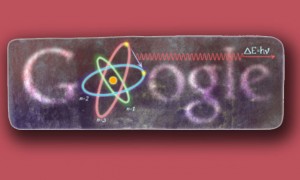Google doodle and Niels Bohr 127th birthday
Niels Bohr (famous Danish physicist and a Nobel Prize winner for his contribution to the field of physics) is the subject of Sunday’s Google doodle.
Niels Bohr, was born Niels Henrik David Bohr on 7 October 1885 in Copenhagen, Denmark. His father Christian Bohr was a professor of physiology at the University of Copenhagen, and the man who observed the phenomenon called Bohr shift or Bohr effect. At age 18, Niels Bohr enrolled as an undergraduate at Copenhagen University, initially studying philosophy and mathematics.
Niels Bohr continued as a graduate student at the University of Copenhagen receiving his doctorate in 1911. In 1912 joined Ernest Rutherford at Victoria University of Manchester, where he spent four years in association with the older physics professor and became part of the group that included scientists such as William Lawrence Bragg, James Chadwick and Hans Geiger, that involved itself with studying the structure of the atom.
Niels Bohr published his model of atomic structure in 1913 where he introduced the theory of electrons traveling in orbits around the atom’s nucleus, the chemical properties of each element being largely determined by the number of electrons in the outer orbits of its atoms. Bohr also introduced the idea that an electron could drop from a higher-energy orbit to a lower one, in the process emitting a photon, light quantum, of discrete energy. This became a basis for quantum theory.
Niels Bohr was a Danish physicist, who was awarded the Nobel Prize in Physics 1922 “for his services in the investigation of the structure of atoms and of the radiation emanating from them”. Niels Henrik David Bohr was born in Copenhagen on October 7, 1885. His father (Christian Bohr) was a Professor of Physiology at Copenhagen University.
Earlier in 1910, Niels Bohr had met Margrethe Norlund, sister of the mathematician Niels Erik Norlund. They tied the know in Copenhagen in 1912. In 1922, Bohr was awarded the Nobel Prize in Physics. In 1927, Heisenberg developed his uncertainty principle, while working on the mathematical foundations of quantum mechanics.
During World War II Bohr, fearing arrest by the Germans, escaped to Britain from where he went to the US to work on the Manhattan Project at the Los Alamos laboratory in New Mexico. The Manhattan Project lead to the development of the first atom bomb.
Following the war Bohr returned to Copenhagen. He continued to preach the peaceful use of nuclear energy.
Niels Bohr died in Copenhagen on November 18, 1962. His son (Aage Bohr) was also awarded the Nobel Prize in Physics in 1975.
Here are 10 things you need to know about the scientist…
1. Niels Henrik David Bohr was a Danish physicist, born in Copenhagen on October 7, 1885.
2. His father was Christian Bohr who observed the phenomenon called Bohr shift.
3. Niels took his Master’s degree in Physics in 1909 and his Doctor’s degree in 1911.
4. Niels married Margrethe Norlund – the sister of the mathematician Niels Erik Norlund – in 1912 after dating for two years.
5. In 1913 Niels published his model of atomic structure and also the idea that an electron could emit a photon of discrete energy as it dropped from a higher-energy orbit to a lower one.
6. In 1922 he was awarded the Nobel Prize in Physics “for his services in the investigation of the structure of atoms and of the radiation emanating from them”.
7. He was a keen footballer and he played in goal for Akademisk Boldklub.
8. Fearing arrest by the Germans, Niels fled to Britain during World War II and then to New Mexico to work on the Manhattan Project – a research and development program by the US and UK – that produced the first atomic bomb.
9. Niels appears on the Danish 500 Kroner.
10. He died from heart failure in Copenhagen in 1962.
